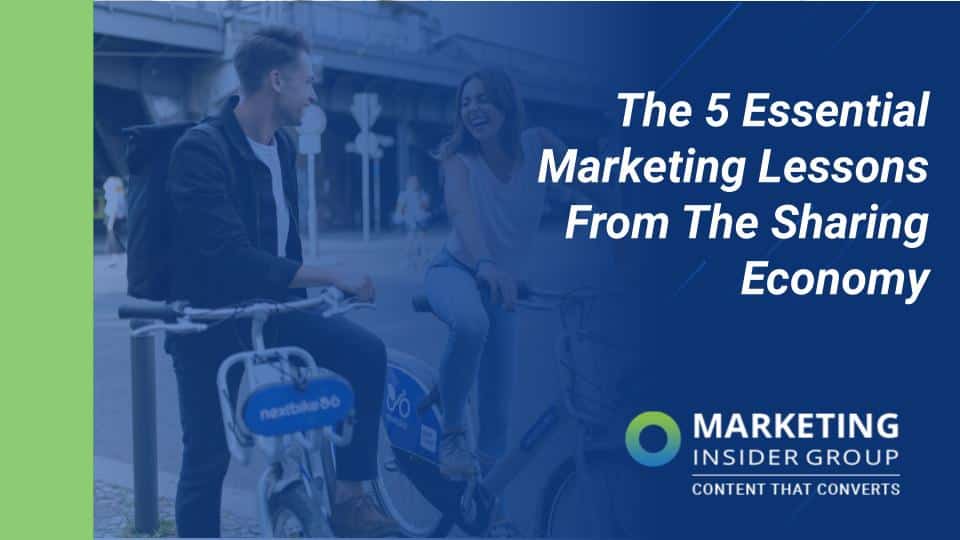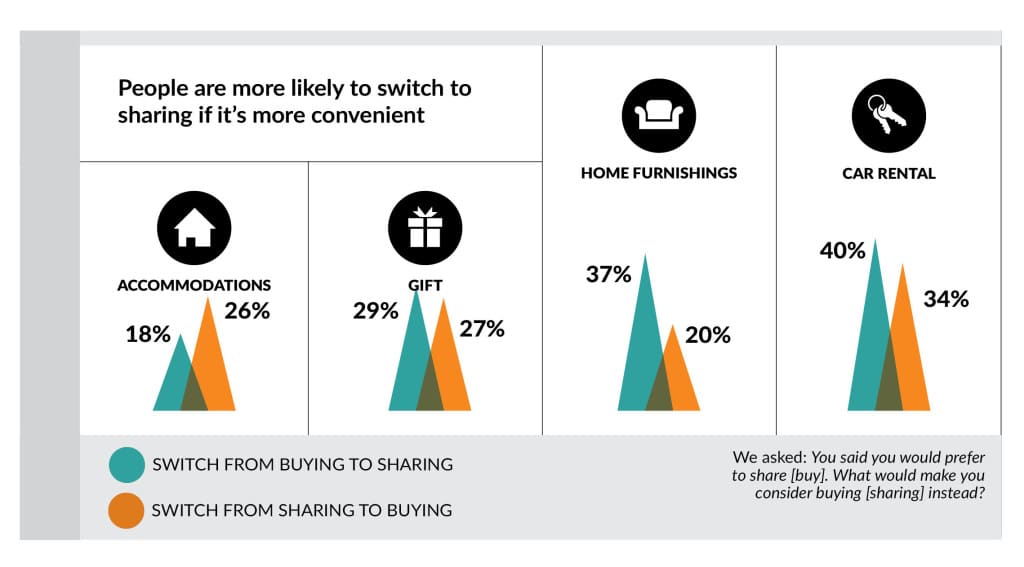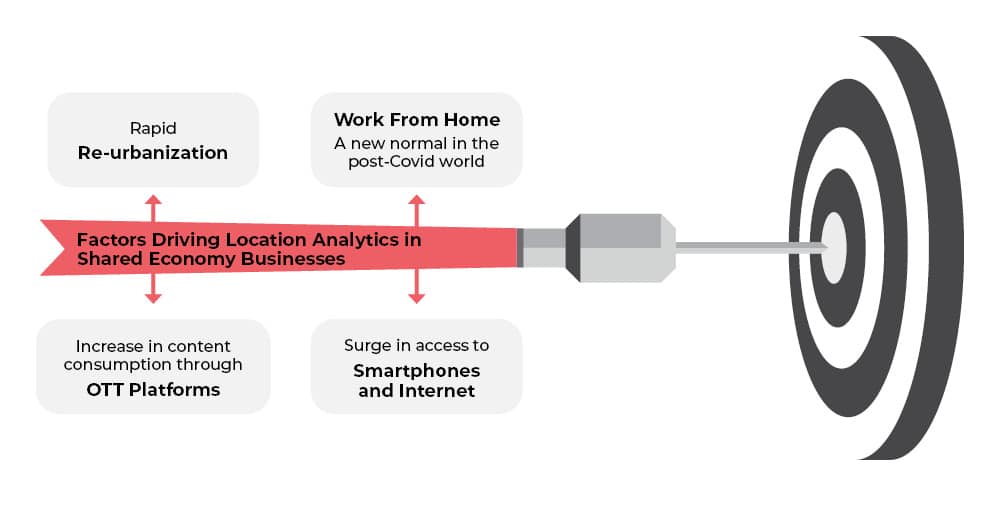
The 5 Essential Marketing Lessons From The Sharing Economy
The sharing economy, simply put, is a new economic model based on a peer-to-peer network system. The concept itself is pretty simple: just strangers sharing everyday goods and services with each other on ye olde internet.
With respect to the ongoing “hustle’, consumer-driven businesses within the sharing economy save buyers money, time, and space. Whether you’re looking for a pet sitter on Rover, a ride to the airport with Uber, or even just a place to park (Yes! There’s an app for that, too) these companies are giving regular people more control in almost every industry.
New tech start-ups within the sharing economy seem to be popping up each week — and they’re taking a significant share of revenue from their traditional counterparts. Reuters even reported AirBnb as accounting for 18% of U.S. lodging revenue in 2020 — outperforming both the hotel industry and online travel agent sites like Expedia.
Having perpetually changed the world of consumerism, the sharing economy has allowed new multi-million dollar businesses to blossom overnight. So, how can traditional businesses leverage the sharing economy? Here are five essential marketing lessons that you can use to lean into — and learn from — the sharing economy.
Quick Takeaways
- Bring people together through co-creation.
- Empower your customer and inspire loyalty.
- Sharing is a social exchange – integrate social to build trust with your buyers.
- Use user feedback to craft the perfect website.
- Build your business through community awareness.
1. Co-create
At the heart of successful companies within the sharing economy, like Uber and AirBnb, is a resilient community. Co-creation brings people together to create something valuable for both parties. Traditional businesses can learn from this by working in a collaborative way with customers to bring in outside perspectives and fresh ideas
Co-creation puts the human experience at the center of the enterprise’s model. Use crowdsourcing to drive product innovation while encouraging customer participation. This inspires loyalty within your buyers, and makes them feel like they’re a part of something. Which is what we all want anyway, right? One of my favorite examples is the Starbucks program where customers can nominate a new coffee.
Tech companies often use open-source platforms to drive innovation and participation. Co-creation is a powerful brand tool in the sharing economy. When consumers become co-creators in a brand experience, they are more likely to buy into the brand.
2. Build Trust
Trust is the currency of the sharing economy. At the backbone of that trust is a brand that empowers their customer. The trust that consumers have in your brand will determine whether they will choose traditional buying over sharing, and vice-versa.
Use customer reviews and community-building strategies to develop authority and trust with your customers. Customer reviews are super helpful here, and they can assist you in better anticipating and resolving issues. For the consumer, they create ongoing engagement with your brand which empowers the customer. From a business perspective, they do a lot in developing our understanding of what motivates buyers.
The sharing economy requires people to put their trust in complete strangers. Marketers can leverage social proof and peer reviews to build trust and loyalty with customers at a grass roots level.
3. Integrate Social
Social integration is becoming the most important element of brand discovery and engagement. People switch to sharing because it’s convenient. But they’re also switching because sharing itself is a social exchange.

Building an engaged network of brand advocates takes work. Make every brand experience a social one where customers can engage, share, and establish a communal identity.
In fact, studies have shown that when consumer’s feel that other consumer’s on the platform they’re using are psychologically present, they’re more likely to develop trust and loyalty to that platform. And trust empowers the customer.
4. Build A Great Website
Take a few pointers from the best sharing economy websites. Peer reviews, simplified navigation, local information, and the use of maps, imagery and video make these sites engaging experiences.
Convenience and accessibility are the meat and potatoes of the sharing economy. So, having easy access to products and services on your website is a must. To do this, optimize your site for various devices.
I know we’ve all been there — you pull a website up on your phone and it’s annoying as all hell to navigate or even read.
To help you with this, try to use client feedback to figure out what the best experience would be. Think about what features are distracting, what features are adding to your experience, and challenge assumptions — get creative! Try using our ultimate website launch checklist we’ve put together here.
A good way to do this is to just sit down and map out both the entire user experience, and the administrative experience. This way, you have an entire blueprint for the whole product that is your website. This also makes it possible for you to work out the kinks ahead of time, instead of after things are already up and running.
If you’re not the most tech savvy, the following video does a great job of explaining the basics. And, yes, there’s a crowdsourcing platform for web development out there, too.
5. Micro-Target Communities
The sharing economy is hyper-local; it builds business through community awareness. Larger companies often don’t spend time on the type of community engagement that is the hallmark of sharing economy brands. Take the time to seed your brand story in your neighborhood and develop brand-building campaigns in targeted communities.
Location data and analytics fuel businesses within the sharing economy. Through geo-location analytics, businesses can identify market trends and plan ahead. For example, let’s say you own a sneaker company. If location data is showing you a high density of shoe stores in a certain area, you know that these people are having to travel from X, Y, and Z to get their shoes. Therefore, you can determine where the community needs another store.

With rapid re-urbanization, more people (especially millennials) are moving out of the suburbs and into the city. This rise in population density creates an even greater need for easily accessible business within the sharing economy.
Also, with more people working from home or having hybrid schedules, delivery services that operate with a shared economy business model, like GoPuff or DoorDash, need to rely on location-based analytics.
Have an open mind.
Instead of looking at the sharing economy as a huge threat to many businesses, see it as something you can learn from. Peer-to-peer networks present a tremendous opportunity for leaders and visionary companies who are ready to build new innovative business models that lean into this new economy. How are you tapping into the sharing economy?
Are you ready to take inspiration from the sharing economy and build a new, innovative business model? Figuring out where to start is always the hardest part. If you need some help, check out our SEO Blog Writing Services or set up a free consultation with us here.







The sharing economy opens another opportunity for business-minded individuals. Thanks for the points you shared. I agree, creating a website and establishing presence on social media will contribute a lot in this type of business.
great article, but those 5 marketing lessons have been around for quite a while, – even before the sharing economy stole the picture and forced companies to focus even more on social and online marketing ?
Totally agree Lone. Now the digital, social, mobile revolution is making them even more important. One debate I love to have with CMOs: Has marketing changed or is it the same old techniques just in a different context? What do you think?
That’s right and yet still have to make the argument to some. I think we’ll see an amazing change in the next few years as the traditional brand-centric approach becomes more obviously flawed and customer-centricity paves the way to success.
I would argue it’s a major shift in how we market. Many of the traditional brands are still giving lip service to digital, social, brand influencer marketing while the bulk of the spend is still allocated to media spend.